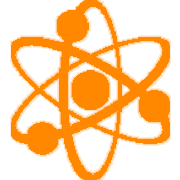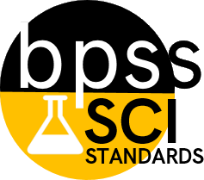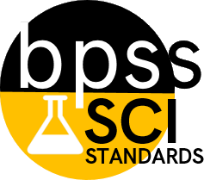SCI-HS.PS2.06
 High School (SCI) Physical Science Standards High School (SCI) Physical Science Standards
[PS2] Motion and Stability: Forces and Interactions
SCI-HS.PS2.06 Communicate scientific and technical information about why the molecular-level structure is important in the functioning of designed materials.
Clarification Statement: Chemistry: Emphasis is on the attractive and repulsive forces that determine the functioning of the
material. Examples could include why electrically conductive materials are often made of metal,
flexible but durable materials are made up of long chained molecules, and pharmaceuticals are
designed to interact with specific receptors
Disciplinary Core Ideas
PS2.B: Types of Interactions
Attraction and repulsion between electric charges
at the atomic scale explain the structure,
properties, and transformations of matter, as well
as the contact forces between material objects.
Student Learning Targets:
Knowledge Targets
Reasoning Targets
Skills (Performance) Targets
Product Targets
Student "I can" statements are embedded within the proficiency scale.
Proficiency Scale for Bonding and Intermolecular Forces (Chemistry)
| Score |
|
Description |
Student Targets and Activities |
| 4.0 |
In addition to Score 3.0, the student demonstrates in-depth inferences and applications regarding more complex material that go beyond end of instruction expectations. |
|
| |
3.5 |
In addition to Score 3.0 performance, the student demonstrates in-depth inferences and applications regarding the more complex content with partial success. |
| 3.0 |
“The Standard.” The student demonstrates no major errors or omissions regarding any of the information and processes that were end of instruction expectations.
HS-PS1-1-Use the periodic table as a model to predict the relative properties of elements based on the patterns of electrons in the outermost energy level of atoms (for example, use information on the periodic table to predict relative properties-such as the reactivity of metals, types of bonds formed, number of bonds formed, and reaction with oxygen-of main group elements).
HS-PS1-3- Plan and conduct an investigation to gather evidence to compare the structure of substances at the bulk scale to infer the strength of electrical forces between particles (for example, figure out the strength of electrical forces between ions, atoms, molecules, or networked materials-such as graphite-by investigating the structure and characteristics of different substances at the bulk scale, including melting point, boiling point, vapor pressure, and surface tension. A suggestion would be to have students construct and revise an explanation for the behaviors of solutes and solvents of differing polarity and the practical applications of various materials in real-world applications. ).
HS-PS2-6-Communicate scientific and technical information about why the molecular-level structure
is important in the functioning of designed materials (for example, use teacher-provided molecular-level structures of specific designed materials-such as electrically conductive metals, flexible but durable materials, and pharmaceuticals designed to interact with specific receptors-to explain how attractive and repulsive forces at the molecular level determine function).
|
- Determine the strength of a chemical bond between to ions.
- Determine the characteristics of the electrons involved in a chemical bond based on electronegativity values.
- Identify whether a bond is covalent or ionic based solely on electronegativity data for the respective ions.
- Differentiate between values of a Van der Waals radius and a covalent radius.
- Compare and contrast ionic radii (both cation and anion) to a stable atom.
- Determine the covalent radius when provided with internuclear distance information.
|
| |
2.5 |
The student demonstrates no major errors or omissions regarding the simpler details and processes (Score 2.0 content) and partial knowledge of the more complex ideas and processes (Score 3.0 content). |
| 2.0 |
The student demonstrates no major errors or omissions regarding the simpler details and processes but exhibits major errors or omissions regarding the more complex ideas and processes (Score 3.0 content).The student will:HS-PS1-1
- Recognize and recall specific vocabulary (for example, atom, atomic mass, atomic nucleus, atomic number, bond, electron, element, element stability, elements of matter, main group element, model, neutron, outermost energy level, pattern, periodic table, predict, property, proton, reaction, reactivity, relative, relative mass, weight of subatomic particles).
- Use the periodic table to gather information about main group elements.
HS-PS1-3
- Recognize and recall specific vocabulary (for example, atom, atomic energy, boiling point, bulk scale, characteristic, electrical force, elementary particle, ion, melting point, molecule, networked material, particle, strength, structure, substance, surface tension, vapor pressure).
- Model the structures of various substances. Describe the relationship between electrical forces and particles.
HS-PS2-6
- Recognize or recall specific vocabulary (for example, attractive, designed material, durable, electrically conductive, electron configuration, electron sharing, electron transfer, flexible, force, formation of polymers, function, ionic motion, isotope, molecular arrangement, molecular level, molecular motion, pharmaceutical, receptor, repulsive, structure, synthetic polymer.
- Describe the structure of different substances at the molecular level.
- Describe the relationship between attractive and repulsive forces at the molecular level.
|
- Define and identify electronegativity trends from the periodic table.
- Identify physical traits of compounds formed by covalent and ionic bonds.
- Identify the bond axis, bond angle, and bond length of a covalent molecule.
|
| |
1.5 |
The student demonstrates partial knowledge of the simpler details and processes (Score 2.0 content) but exhibits major errors or omissions regarding the more complex ideas and procedures (Score 3.0 content). |
| 1.0 |
With help, the student demonstrates a partial understanding of some of the simpler details and processes (Score 2.0 content) and some of the more complex ideas and processes (Score 3.0 content). |
- |
| |
0.5 |
With help, the student demonstrates a partial understanding of some of the simpler details and processes (Score 2.0 content) but not the more complex ideas and processes (Score 3.0 content). |
Resources
Websites
Vocabulary
Proficiency Scale for Structure & Properties of Matter (Chemistry)
| Score |
|
Description |
Student Targets and Activities |
| 4.0 |
In addition to Score 3.0, the student demonstrates in-depth inferences and applications regarding more complex material that go beyond end of instruction expectations.
Student can perform all expectations at “Proficient” (3.0) level without use of a list of selected polyatomic ions (“from memory”). |
|
| |
3.5 |
In addition to Score 3.0 performance, the student demonstrates in-depth inferences and applications regarding the more complex content with partial success. |
| 3.0 |
“The Standard.” The student demonstrates no major errors or omissions regarding any of the information and processes that were end of instruction expectations.
The student:
HS-PS1-1- Use the periodic table as a model to predict the relative properties of elements based on the patterns of electrons in the outermost energy level of atoms (for example, use information on the periodic table to predict relative properties-such as the reactivity of metals, types of bonds formed, number of bonds formed, and reaction with oxygen-of main group elements).
HS-PS1-3- Plan and conduct an investigation to gather evidence to compare the structure of substances at the bulk scale to infer the strength of electrical forces between particles (for example, figure out the strength of electrical forces between ions, atoms, molecules, or networked materials-such as graphite-by investigating the structure and characteristics of different substances at the bulk scale, including melting point, boiling point, vapor pressure, and surface tension). Identify and explain physical properties (e.g., density, melting point, boiling point, conductivity, malleability) and chemical properties (e.g., the ability to form new substances).
HS-PS2-6. Communicate scientific and technical information about why the molecular-level structure
is important in the functioning of designed materials (for example, use teacher-provided molecular-level
structures of specific designed materials-such as electrically conductive metals, flexible but durable materials, and pharmaceuticals designed to interact with specific receptors-to explain how attractive and repulsive forces at the molecular level determine function).
|
- Explains the similarities and differences between the 3 states of matter, with examples
- Discusses the differences between chemical and physical changes, with examples
- Discusses the term “phase” in terms of homogeneous and heterogeneous mixtures
- Separates various mixtures using physical properties
- Discusses multiple ways a mixture may be separated using physical properties
- Communicates a knowledge of the difference between a chemical formula and a chemical reaction by providing examples of each
- Differentiates between qualitative and quantitative data through the use of examples
|
| |
2.5 |
The student demonstrates no major errors or omissions regarding the simpler details and processes (Score 2.0 content) and partial knowledge of the more complex ideas and processes (Score 3.0 content). |
| 2.0 |
The student demonstrates no major errors or omissions regarding the simpler details and processes but exhibits major errors or omissions regarding the more complex ideas and processes (Score 3.0 content).
HS-PS1-1.
The student will:
- Recognize and recall specific vocabulary (for example, atom, atomic mass, atomic nucleus, atomic number, bond, electron, element, element stability, elements of matter, main group element, model, neutron, outermost energy level, pattern, periodic table, predict, property, proton, reaction, reactivity, relative, relative mass, weight of subatomic particles).o Use the periodic table to gather information about main group elements.
HS-PS1-3.
The student will:
- Recognize and recall specific vocabulary (for example, atom, atomic energy, boiling point, bulk scale, characteristic, electrical force, elementary particle, ion, melting point, molecule, networked material, particle, strength, structure, substance, surface tension, vapor pressure).
- Model the structures of various substances.
- Describe the relationship between electrical forces and particles.
HS-PS2-6.
The student will:
- Recognize or recall specific vocabulary (for example, attractive, designed material, durable, electrically conductive, electron configuration, electron sharing, electron transfer, flexible, force, formation of polymers, function, ionic motion, isotope, molecular arrangement, molecular level, molecular motion, pharmaceutical, receptor, repulsive, structure, synthetic polymer.
- Describe the structure of different substances at the molecular level.
- Describe the relationship between attractive and repulsive forces at the molecular level.
|
- Identifies properties of the 3 states of matter
- Recognizes examples of chemical and physical changes
- Identifies a homogeneous and heterogeneous mixture when given examples
- Identifies physical properties when given examples
- Recognizes ways that solutions may be separated using physical properties
- Recognizes examples of chemical formulas and chemical reactions
- Recognizes the differences between qualitative and quantitative data when given examples
|
| |
1.5 |
The student demonstrates partial knowledge of the simpler details and processes (Score 2.0 content) but exhibits major errors or omissions regarding the more complex ideas and procedures (Score 3.0 content). |
| 1.0 |
With help, the student demonstrates a partial understanding of some of the simpler details and processes (Score 2.0 content) and some of the more complex ideas and processes (Score 3.0 content). |
- |
| |
0.5 |
With help, the student demonstrates a partial understanding of some of the simpler details and processes (Score 2.0 content) but not the more complex ideas and processes (Score 3.0 content). |
Resources
Websites
Vocabulary
Proficiency Scale for Atomic Theory (Chemistry)
| Score |
|
Description |
Student Targets and Activities |
| 4.0 |
In addition to Score 3.0, the student demonstrates in-depth inferences and applications regarding more complex material that go beyond end of instruction expectations.
Student can perform all expectations at “Proficient” (3.0) level without use of a list of selected polyatomic ions (“from memory”). |
|
| |
3.5 |
In addition to Score 3.0 performance, the student demonstrates in-depth inferences and applications regarding the more complex content with partial success. |
| 3.0 |
“The Standard.” The student demonstrates no major errors or omissions regarding any of the information and processes that were end of instruction expectations.
HS-PS1-1.
Use the periodic table as a model to predict the relative properties of elements based on the patterns of electrons in the outermost energy level of atoms. [Clarification Statement: Examples of properties that could be predicted from patterns could include reactivity of metals, types of bonds formed, numbers of bonds formed, and reactions with oxygen.] (for example, use information on the periodic table to predict relative properties-such as the reactivity of metals, types of bonds formed, number of bonds formed, and reaction with oxygen-of main group elements).
HS-PS1-3. Plan and conduct an investigation to gather evidence to compare the structure of substances at the bulk scale to infer the strength of electrical forces between particles. [Clarification Statement: Emphasis is on understanding the strengths of forces between particles, not on naming specific intermolecular forces (such as dipole-dipole). Examples of particles could include ions, atoms, molecules, and networked materials.]
HS-PS2-6. Communicate scientific and technical information about why the molecular-level structure is important in the functioning of designed materials (for example, use teacher-provided molecular-level structures of specific designed materials-such as electrically conductive metals, flexible but durable materials, and pharmaceuticals designed to interact with specific receptors-to explain how attractive and repulsive forces at the molecular level determine function).
|
|
| |
2.5 |
The student demonstrates no major errors or omissions regarding the simpler details and processes (Score 2.0 content) and partial knowledge of the more complex ideas and processes (Score 3.0 content). |
| 2.0 |
The student demonstrates no major errors or omissions regarding the simpler details and processes but exhibits major errors or omissions regarding the more complex ideas and processes (Score 3.0 content).
HS-PS1-1
The student will:
- Recognize and recall specific vocabulary (for example, atom, atomic mass, atomic nucleus, atomic number, bond, electron, element, element stability, elements of matter, main group element, model, neutron, outermost energy level, pattern, periodic table, predict, property, proton, reaction, reactivity, relative, relative mass, mass of subatomic particles).
- Use the periodic table to gather information about main group elements.
HS-PS1-3.
The student will:
- Recognize and recall specific vocabulary (for example, atom, atomic energy, boiling point, bulk scale, characteristic, electrical force, elementary particle, ion, melting point, molecule, networked material, particle, strength, structure, substance, surface tension, vapor pressure).
- Model the structures of various substances.
- Describe the relationship between electrical forces and particles.
|
|
| |
1.5 |
The student demonstrates partial knowledge of the simpler details and processes (Score 2.0 content) but exhibits major errors or omissions regarding the more complex ideas and procedures (Score 3.0 content). |
| 1.0 |
With help, the student demonstrates a partial understanding of some of the simpler details and processes (Score 2.0 content) and some of the more complex ideas and processes (Score 3.0 content). |
- |
| |
0.5 |
With help, the student demonstrates a partial understanding of some of the simpler details and processes (Score 2.0 content) but not the more complex ideas and processes (Score 3.0 content). |
Resources
Websites
Vocabulary
|
 (PS) Physical Science
(PS) Physical Science

 DCI Physical Science PS3
DCI Physical Science PS3